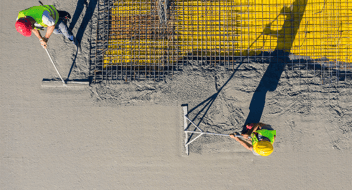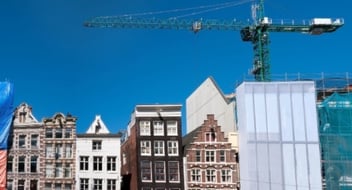
The construction industry’s impact on global emissions is now well documented. It is widely known, and even more widely written, that the Built Environment contributes to 40% of global carbon emissions and that construction activity accounts for 33% of waste sent to landfill. However, to add more context to these numbers and better understand the depth of the problem:
1. Over the next 40 years, the world will build an additional 230 billion square meters in new construction – which is the equivalent of building a new Paris each week. Without action, this will introduce an enormous amount of additional CO2 into the atmosphere.
2. Every 1 tonne of concrete created for building generates 1.15 tonnes of CO2. Concrete is one of the world’s most carbon intensive industries, accounting for 7% of Green House Gas emissions alone.
3. Around 2/3 of freight transport in cities globally is transported to and from construction sites, much of which is waste material designated for landfill. The scope 3 emissions from these vehicles are immense.
Sustainability in the Middle East
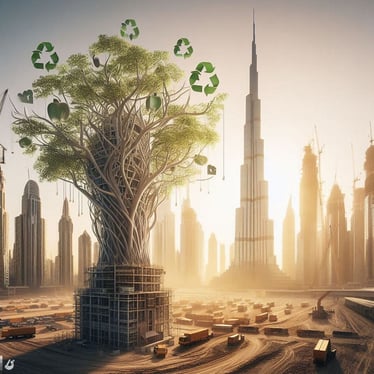
The Carbon problem has become a growing concern specifically in the Middle East, where demand for real estate and commercial buildings has increased exponentially, exacerbating the construction industry’s environmental impact. As a result, governments are now taking action.
As an example, ahead of COP28 this month, the UAE government has introduced regulations and standards to incentivize sustainable development. In Abu Dhabi, firms have adopted the Pearl rating system (Estidama), in Dubai there is the Green Building Rating system, and in Ras-al-Khaimah there is the Barjeel rating system.
Regional governments are now recognizing the need for change, and we at Asite are seeing many stakeholders in the region trying to implement more sustainable processes. However, there is a fundamental blocker preventing industry from making the mass change required, which is the lack of access to accurate and complete underlying ESG data.
Traditional sustainability data collection and reporting methods, which predominantly involve Excel, fall short in providing a full picture of environmental conditions on site. Data siloes and poor data governance prevent firms from gaining complete insight into the true ESG impact of a project portfolio.
Unfortunately, without accurate data and a clear understanding of ESG impacts today, project managers are unable to make the comprehensive changes required to secure a better tomorrow. As a result, there is a critical need for technology to step in and offer a more transparent and efficient solution.
Introducing Asite Sustainability
This is where Asite is driving change, starting in the Middle East and Africa region (MEA). Recognizing the pressing need for new solutions, Asite, in conjunction with Aldar, one of the largest developers in the UAE, has developed a new, powerful and completely configurable Sustainability tool that revolutionizes how stakeholders collect, analyze and report sustainability data.
Through Asite, stakeholders rest assured that they have an accurate picture of their true ESG metrics and impact across all construction projects. The Sustainability module seamlessly combines a portfolio wide ESG data ingestion system with Asite's industry leading CDE and powerful Project Portfolio Management (PPM) suite. This provides users with one of the most comprehensive toolsets on the market to monitor and optimize construction projects for sustainability.
Asite Sustainability's unique selling point is the breadth and depth of ESG data collected and reported. In one platform, our customers track project carbon emissions, materials waste, energy consumption, water usage, and – last, but not least - worker’s welfare. We recognize that the social component of “ESG” is of paramount importance to the MEA region in particular, and with our worker’s welfare module, we have tailored the Asite Sustainability solution to meet this regional demand.
Key Features of Asite Sustainability:
1. Carbon Emissions Tracking: The module offers real-time insights into true carbon emissions throughout the construction process. This data allows project managers to centralize data, identify areas for improvement and implement strategies to reduce their overall carbon footprint.
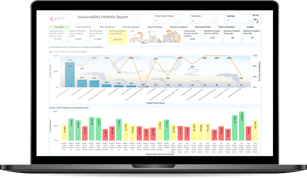
2. Water Intensity Analysis: Water is a precious resource, and the Sustainability module helps construction teams monitor and optimize water usage. By identifying areas of high water intensity, projects can implement water-efficient practices, contributing to a more sustainable approach.
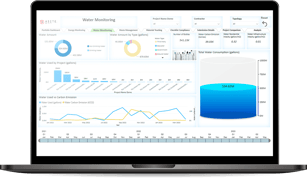
3. Waste Management: Efficient waste management is crucial for sustainability, especially given the excessive waste produced during construction. The Asite module allows construction teams to track and minimize waste across all stages of the project, promoting a circular economy and reducing environmental impact.
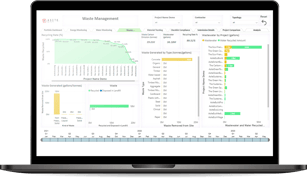
4. Workers Welfare Management: Beyond environmental concerns, the module also addresses social responsibility. Construction projects can utilize the tool to monitor workers' welfare, ensuring a safe and healthy working environment.
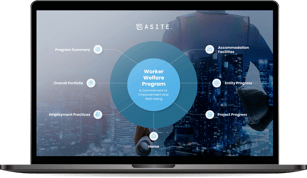
5. Materials Tracking: Gain full visibility and control over your material usage. Ensure accurate inventory management, minimizing waste and promoting sustainable resource allocation.
![]()
6. Carbon Visualization: Leverage the Asite 3D Repo platform for quick and completely novel visualization of real-time embodied carbon metrics. Combine 3D models and LCA data to create comparative dashboards for eco-friendly construction options to present to project stakeholders and clients.
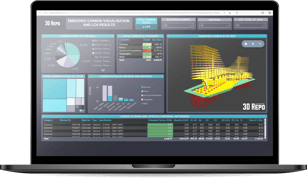
Working with Aldar's Sustainability Team

Aldar, one of the Middle East's largest and most influential real estate developers, has joined forces with Asite to champion sustainability in construction. Aldar utilizes the Asite Sustainability module to monitor and manage true carbon emissions, water intensity, workers' welfare, and waste across it’s entire supply chain of contractors and subcontractors.
By leveraging this innovative technology, Aldar has demonstrated its dedication to building a sustainable future and has become one of the most forward-thinking developers in the region. The collaboration between Asite and Aldar exemplifies the industry's potential for change when we combine technological innovation with a true commercial commitment to environmental responsibility.
Signs of a Greener Future
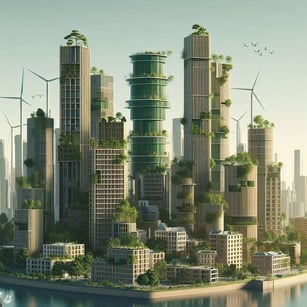
Fortunately, we see the market demand for products like Asite Sustainability growing exponentially. In Europe, 82% of AEC firms now have a sustainability team in place. These teams will be pivotal in driving sustainable change over the next 5 years and realizing significant benefits for their organizations.
By adopting more sustainable practices, not only can AEC companies demonstrate their commitment to ESG to investors and customers, they also stand to make significant cost savings. 75% of organizations that do adopt sustainable technologies report better utilization of construction resources. This includes reduced input material, reduced energy consumption and reduced errors, all of which shed cost.
As the construction industry continues to evolve, embracing sustainability is no longer an option, but a necessity. Asite's Sustainability module, in collaboration with industry leaders like Aldar, exemplifies how technology can empower construction professionals to make informed decisions that benefit both the environment and society. By adopting these solutions, the construction industry can pave the way from being an ESG laggard to a beacon for a sustainable future. If you are interested in creating a greener and more productive industry, please do be in touch with myself or the Asite team.
Meet the team here: https://www.asite.com/book-your-demo-sustainability
4 minute read
Asite Insights in your inbox.
Sign up for product news and our latest insights published monthly. It's a newsletter so hot, even global warming can't keep up.

